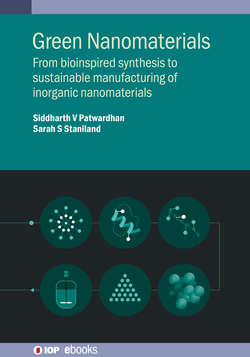Читать книгу Green Nanomaterials - Siddharth Patwardhan - Страница 4
На сайте Литреса книга снята с продажи.
Contents
ОглавлениеPreface
Acknowledgements
Author biographies
Section I Green chemistry principles
1 Green chemistry and engineering
1.1 Principles of green chemistry and engineering
1.1.1 Overview
1.1.2 Drivers for green approaches
1.1.3 Estimating environmental impact
1.2 Ways to improve sustainability
1.3 Green chemistry and nanomaterials
References
Section II Nanomaterials
2 Nanomaterials: what are they and why do we want them?
2.1 Fundamentals of the nanoscale
2.2 Tangible and historical examples of nanomaterials
2.3 Special properties offered by the nanoscale
2.3.1 Optical: surface plasmon resonance
2.3.2 Optical: quantum dots fluorescence
2.3.3 Electron spin and nanomagnetism
2.4 Applications
2.4.1 Nanomedicine
2.4.2 Nanodevice technologies
2.4.3 Consumer products
2.5 Nanomaterial biocompatibility and toxicity
2.6 Summary: key lessons from nanomaterials, nanoproperties and applications
Summary of content
Key lessons
References
3 Characterisation of nanomaterials
3.1 Introduction
3.2 Microscopy
3.2.1 Optical microscopy
3.2.2 Electron microscopy
3.2.3 Scanning electron microscopy
3.2.4 Transmission electron microscopy
3.2.5 Atomic force microscopy
3.3 Spectroscopy applied to nanomaterials
3.3.1 Mass spectrometry
3.3.2 Infra-red spectroscopy
3.3.3 X-ray photoelectron spectroscopy
3.4 Diffraction and scattering techniques
3.4.1 X-ray diffraction (XRD)
3.4.2 Dynamic light scattering
3.4.3 Small angle scattering
3.5 Porosimetry
3.6 Summary: key lessons for characterisation of nanomaterials
References
4 Conventional methods to prepare nanomaterials
4.1 Top-down and bottom-up methods
4.2 Top-down methods
4.3 Bottom-up methods
4.4 Nucleation and growth theory
4.4.1 Homogeneous nucleation
4.4.2 Heterogeneous nucleation
4.4.3 Growth
4.5 Conventional bottom-up methods
4.5.1 Vapour-phase method
4.5.2 Solution processing
4.5.3 Spray conversion
4.5.4 Sol–gel method
4.6 Emerging bottom-up methods
4.6.1 Principles and overview
4.6.2 Soft lithography
4.6.3 Dip-pen nanolithography
4.6.4 Layer-by-layer self-assembly
4.6.5 Solution synthesis of nanoparticles
4.6.6 Templated synthesis
4.7 Summary: key lessons about conventional routes to nanomaterials
References
Section III From biominerals to green nanomaterials
5 Green chemistry for nanomaterials
5.1 Sustainability of nanomaterials production
5.2 Reasons behind unsustainability
5.3 Evaluation of sustainability for selected methods
5.3.1 E-factors for solution methods
5.3.2 How green is soft lithography?
5.3.3 Templated synthesis: surely sustainable?
5.4 Adopting green chemistry for nanomaterials
5.5 Biological and biochemical terminology and methods
5.5.1 Molecular biology component
5.5.2 Molecular biological techniques
5.6 Summary: key lessons about sustainability nanomaterials production
References
6 Biomineralisation: how Nature makes nanomaterials
6.1 Introduction
6.2 Properties and function of biomineral types
6.2.1 Bio-calcium phosphate (hydroxyapatite): mechanical/structural support, motion, cutting/grinding
6.2.2 Bio-calcium carbonate: protection, sensor, buoyancy
6.2.3 Bio-silica: mechanical support, transport and protection
6.2.4 Bio-magnetite: sensing, cutting/grinding, iron storage
6.3 Mineral formation controlling strategies in biomineralisation
6.3.1 The universal biomineralisation process
6.4 Roles and types of organic biological components required for biomineralisation
6.4.1 Roles of organic biological components
6.4.2 Types of organic biological components
6.5 Summary: key lessons from biomineralisation for the green synthesis of nanomaterials
References
7 Bioinspired ‘green’ synthesis of nanomaterials
7.1 From biological to bioinspired synthesis
7.2 Mechanistic understanding
7.2.1 Biomineralising biomolecules
7.2.2 Abiotic peptides and proteins from biopanning
7.3 An illustration of exploiting the knowledge of nano–bio interactions
7.4 Additives as the mimics of biomineral forming biomolecules
7.4.1 The need for additives
7.4.2 The design of additives and custom synthesis
7.5 Compartmentalisation, templating and patterning
7.5.1 Confinement in a simple protein template
7.5.2 Confinement in modified cage protein templates
7.5.3 Biomimetic compartmentalisation
7.5.4 Localisation and patterning on surfaces
7.6 Scalability of bioinspired syntheses
7.7 Summary: key lessons about the journey towards bioinspired synthesis
References
Section IV Case studies
8 Case study 1: magnetite nanoparticles
8.1 Magnetite biomineralisation in magnetotactic bacteria
8.2 Magnetosome use in applications: advantages and drawbacks
Advantages
Disadvantages
8.3 Biomolecules and components controlling magnetosome formation
8.3.1 Magnetosome biomineralisation protein discovery
8.3.2 Bio-components for each step of biomineralisation
8.4 Biokleptic use of Mms proteins for magnetite synthesis in vitro
8.5 Understanding Mms proteins in vitro
Iron binding
Self-assembly
8.6 Development and design of additives: emergence of bioinspired magnetite nanoparticle synthesis
8.6.1 Development from biomineralisation proteins: MmsF
8.6.2 Screening non-biomineralisation proteins: magnetite interacting proteins
8.6.3 Biomimetic magnetosomes
8.7 Summary: key learning, and the future (towards manufacture)
References
9 Case study 2: silica
9.1 Biosilica occurrence and formation
9.2 Biomolecules controlling biosilica formation
9.3 Learning from biological silica synthesis: in vitro investigation of bioextracts
9.4 Emergence of bioinspired synthesis using synthetic ‘additives’
9.4.1 Which amino acids are important?
9.4.2 Would (homo)polypeptides be sufficient to promote silica formation?
9.4.3 Peptides from biopanning
9.4.4 Do we need peptides or biomolecules?
9.4.5 Can smaller molecules provide similar activities?
9.5 Benefits of bioinspired synthesis
9.6 From lab to market
9.7 Summary: key learning, summary and the future
References
